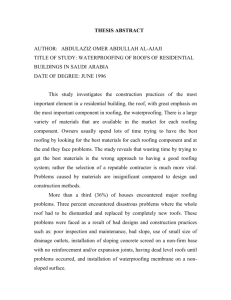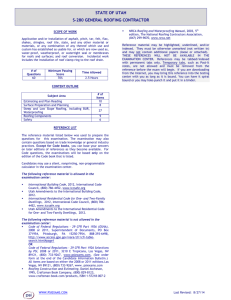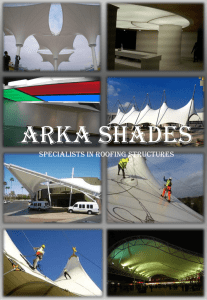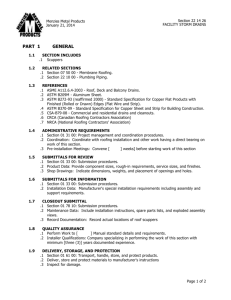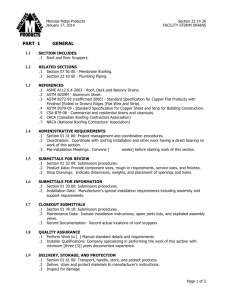SBS UltraWhite Premium Roofing System Spec
advertisement
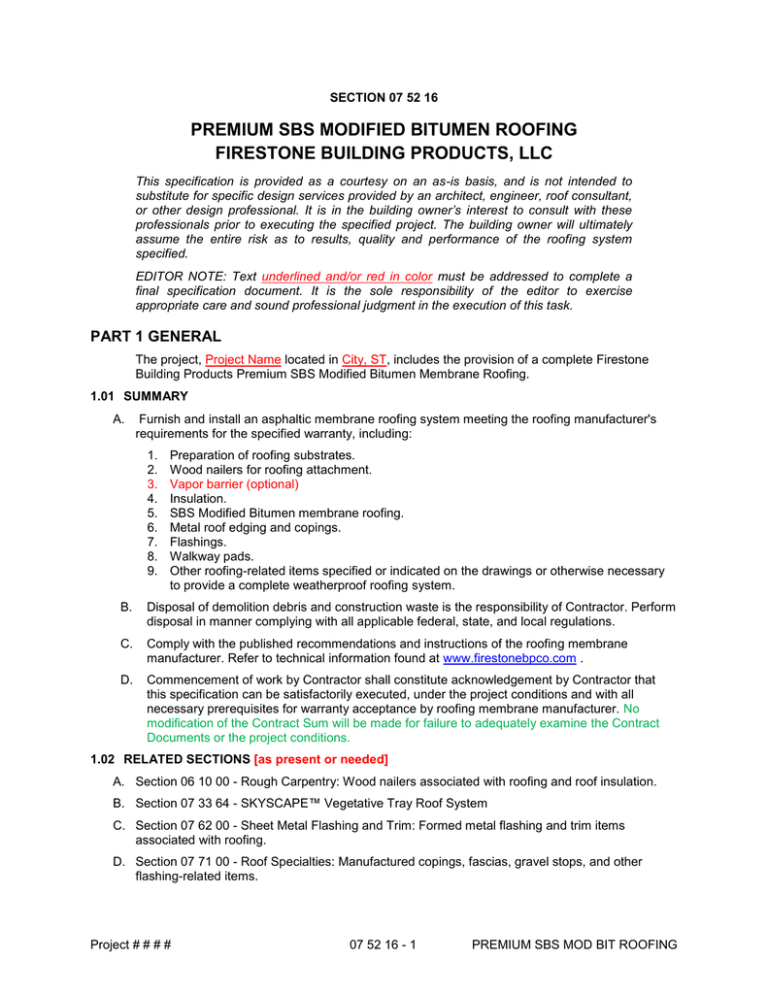
SECTION 07 52 16 PREMIUM SBS MODIFIED BITUMEN ROOFING FIRESTONE BUILDING PRODUCTS, LLC This specification is provided as a courtesy on an as-is basis, and is not intended to substitute for specific design services provided by an architect, engineer, roof consultant, or other design professional. It is in the building owner’s interest to consult with these professionals prior to executing the specified project. The building owner will ultimately assume the entire risk as to results, quality and performance of the roofing system specified. EDITOR NOTE: Text underlined and/or red in color must be addressed to complete a final specification document. It is the sole responsibility of the editor to exercise appropriate care and sound professional judgment in the execution of this task. PART 1 GENERAL The project, Project Name located in City, ST, includes the provision of a complete Firestone Building Products Premium SBS Modified Bitumen Membrane Roofing. 1.01 SUMMARY A. Furnish and install an asphaltic membrane roofing system meeting the roofing manufacturer's requirements for the specified warranty, including: 1. 2. 3. 4. 5. 6. 7. 8. 9. Preparation of roofing substrates. Wood nailers for roofing attachment. Vapor barrier (optional) Insulation. SBS Modified Bitumen membrane roofing. Metal roof edging and copings. Flashings. Walkway pads. Other roofing-related items specified or indicated on the drawings or otherwise necessary to provide a complete weatherproof roofing system. B. Disposal of demolition debris and construction waste is the responsibility of Contractor. Perform disposal in manner complying with all applicable federal, state, and local regulations. C. Comply with the published recommendations and instructions of the roofing membrane manufacturer. Refer to technical information found at www.firestonebpco.com . D. Commencement of work by Contractor shall constitute acknowledgement by Contractor that this specification can be satisfactorily executed, under the project conditions and with all necessary prerequisites for warranty acceptance by roofing membrane manufacturer. No modification of the Contract Sum will be made for failure to adequately examine the Contract Documents or the project conditions. 1.02 RELATED SECTIONS [as present or needed] A. Section 06 10 00 - Rough Carpentry: Wood nailers associated with roofing and roof insulation. B. Section 07 33 64 - SKYSCAPE™ Vegetative Tray Roof System C. Section 07 62 00 - Sheet Metal Flashing and Trim: Formed metal flashing and trim items associated with roofing. D. Section 07 71 00 - Roof Specialties: Manufactured copings, fascias, gravel stops, and other flashing-related items. Project # # # # 07 52 16 - 1 PREMIUM SBS MOD BIT ROOFING E. Section 07 72 00 - Roof Accessories: Roof hatches, vents, and manufactured curbs. F. Section 08 62 00 - SUNWAVE™ Unit Skylights. G. Section 22 10 06 - Plumbing Specialties: Roof drains 1.03 DEFINITIONS A. Roofing Terminology: Refer to ASTM D1079 for definition of terms related to roofing work not otherwise defined in the section. B. LTTR: Long Term Thermal Resistance, as defined by ASTM1289-13ei. 1.04 REFERENCE STANDARDS A. Referenced Standards: These standards form part of this specification only to the extent they are referenced as specification requirements. 1. ASTM C177 - Standard Test Method for Steady-State Heat Flux Measurements and Thermal Transmission Properties by Means of the Guarded-Hot-Plate Apparatus; 2010. 2. ASTM C208 - Standard Specification for Cellulosic Fiber Insulating Board; 2012. 3. ASTM C209 - Standard Test Methods for Cellulosic Fiber Insulating Board; 2012. 4. ASTM C518 - Standard Test Method for Steady-State Thermal Transmission Properties by Means of the Heat Flow Meter Apparatus; 2010. 5. ASTM C1289 - Standard Specification for Faced Rigid Cellular Polyisocyanurate Thermal Insulation Board; 2013. 6. ASTM D1079 - Standard Terminology Relating to Roofing, Waterproofing, and Bituminous Materials; 2013. 7. ASTM D1621 - Standard Test Method for Compressive Properties Of Rigid Cellular Plastics; 2010. 8. ASTM D1622 - Standard Test Method for Apparent Density of Rigid Cellular Plastics; 2008. 9. ASTM D3273 - Standard Test Method for Resistance to Growth of Mold on the Surface of Interior Coatings in an Environmental Chamber; 2012. 10. ASTM D6163 – Standard Specification for Styrene Butadiene Styrene (SBS) Modified Bituminous Sheet Materials using Glass Fiber Reinforcements 11. ASTM D6164 – Standard Specification for Styrene Butadiene Styrene (SBS) Modified Bituminous Sheet Materials using Polyester Reinforcements 12. FM DS 1-28 - Wind Design; Factory Mutual System; 2007. 13. FM DS 1-29 - Roof Deck Securement and Above-Deck Roof Components; Factory Mutual System; 2006. 14. PS 1 - Structural Plywood; 2009. 15. PS 20 - American Softwood Lumber Standard; 2010. 16. SPRI ES-1 - Wind Design Standard for Edge Systems Used with Low Slope Roofing Systems; 2010 or current enforced edition. (ANSI/SPRI ES-1) 1.05 ADMINISTRATIVE REQUIREMENTS A. Pre-Installation Conference: Before start of roofing work, Contractor shall hold a meeting to discuss the proper installation of materials and requirements to achieve the warranty. 1. Require attendance with all parties directly influencing the quality of roofing work or affected by the performance of roofing work. 2. Notify Architect well in advance of meeting. 1.06 SUBMITTALS A. See Section 01 - Administrative Requirements, for submittal procedures. B. Product Data: 1. Provide membrane manufacturer's printed submittal package to show that all components of roofing system, including insulation and fasteners, comply with the specified requirements and with the membrane manufacturer's requirements and recommendations for the system type specified; include data for each product used in conjunction with roofing membrane. Project # # # # 07 52 16 - 2 PREMIUM SBS MOD BIT ROOFING 2. Where UL or FM requirements are specified, provide documentation that shows that the roofing system to be installed is UL-Classified or FM-approved, as applicable; include data itemizing the components of the classified or approved system. C. Samples: Submit samples of each product to be used. D. Shop Drawings: Provide: 1. The roof membrane manufacturer's standard details customized for this project for all relevant conditions, including flashings, base tie-ins, roof edges, terminations, expansion joints, penetrations, and drains. 2. For tapered insulation, provide project-specific layout and dimensions for each board. E. Pre-Installation Notice: Copy to show that manufacturer's required Pre Installation Notice (PIN) has been accepted and approved by the manufacturer. F. Executed Warranty as a requirement of project closeout. G. Specimen Warranty: Submit prior to starting work. H. Samples: Submit samples of each product to be used. 1.07 QUALITY ASSURANCE A. Installer Qualifications: Roofing installer shall have the following: 1. Current Firestone Master Contractor status. 2. Current approval, license, or authorization as applicator by the manufacturer. 3. At least five years experience in installing specified system. 4. Capability to provide a payment performance bond. 1.08 DELIVERY, STORAGE AND HANDLING A. Deliver products in manufacturer's original containers, dry and undamaged, with seals and labels intact and legible. B. Store materials clear of ground and moisture with weather protective covering. C. Keep combustible materials away from ignition sources. 1.09 WARRANTY A. See Division 1 - Closeout Submittals, for additional warranty requirements. B. Comply with all warranty procedures required by manufacturer, including notifications, scheduling, and inspections. C. Warranty: Firestone 15 year, 20 year, 25 year, [or 30 year] Red Shield Limited Warranty covering membrane, roof insulation, and other indicated components of the system, for the noted term. Systems specified with a warranty duration of 20 years or greater or a wind speed coverage above 55 mph require additional attachment and detail considerations. Consult the manufacturer’s design guidelines for further information. Source a 25 or 30 year System specification from your local Firestone Building Products authorized representative. Applications for this duration must be considered by the Manufacturer on an individual basis. A. Limit of Liability: No Dollar Limit. 1. Examples of criteria include the repair of leaks in the roofing system caused by: a. Manufacturing defects in Firestone brand materials. b. Defective workmanship used to install these materials. c. Damage due to winds up to 55 or 72, 80, 90, 100, 110, 120 mph. 2. Examples of criteria excluded from warranty action includes: a. Damage due to winds in excess of 55 or 72, 80, 90, 100, 110, 120 mph. b. Damage due to hurricanes or tornadoes. c. Hail. d. Intentional damage. e. Unintentional damage due to normal rooftop inspections, maintenance, or service. Project # # # # 07 52 16 - 3 PREMIUM SBS MOD BIT ROOFING PART 2 PRODUCTS 2.01 MANUFACTURERS A. Acceptable Manufacturer - Roofing System: Firestone Building Products LLC, Carmel, IN: www.firestonebpco.com. 1. Roofing systems manufactured by others are acceptable provided the roofing system is completely equivalent in materials and warranty conditions and the manufacturer meets the following qualifications: a. Specializing in manufacturing the roofing system to be provided. b. Minimum ten years of experience manufacturing the type of roofing to be provided. c. Able to provide a no dollar limit, single source roof system warranty that is backed by corporate assets in excess of one billion dollars. d. ISO 9002 certified. e. Able to provide isocyanurate insulation that is produced in its own facilities. f. Roofing systems manufactured by the companies listed below are acceptable provided they are completely equivalent in materials and warranty conditions. B. Manufacturer of Insulation and Cover Boards: Same manufacturer as roof membrane. C. Manufacturer of Metal Roof Edging: Same manufacturer as roof membrane. 1. Metal roof edging products by other manufacturers are not acceptable. 2. Field- or shop-fabricated metal roof edgings are not acceptable. D. Substitutions: See Division 01 - Product Requirements. 1. Submit evidence that the proposed substitution complies with the specified requirements. 2.02 ROOFING SYSTEM DESCRIPTION A. Roofing System: Styrene-butadiene-styrene [SBS] modified bitumen membrane. 1. Membrane and Attachment: Mineral granule surfaced cap sheet and base sheet, MB cold adhesive applied, hot asphalt, roofing torch. 2. Slope: Deck is sloped but not enough; provide additional slope of 1/4 inch per foot (1:48 ) by means of tapered insulation. 3. Comply with applicable local building code requirements. 4. Provide assembly having Underwriters Laboratories, Inc. (UL) Class A, B, C, Fire Hazard Classification. 5. Provide assembly complying with Factory Mutual Corporation (FM) Roof Assembly Classification, FM DS 1-28 and 1-29, and meeting minimum requirements of FM 1-90 wind uplift rating. B. Roofing System Components: Listed in order from the top of the roof down: 1. Cover Board: Gypsum-based board, 1/4 inch (6 mm) thick; low rise polyurethane foam attached. 2. Insulation: a. Maximum Board Thickness: 3 inches (75 mm); use as many layers as necessary; stagger joints in adjacent layer. b. Tapered: Slope as indicated; provide minimum R-value at thinnest point; place tapered layer on bottom. c. Total R Value: 20, minimum.Top Layer: Polyisocyanurate foam board, non-composite; MB cold adhesive attached. d. Bottom Layer: Polyisocyanurate foam board, non-composite; low rise polyurethane foam. e. Crickets: Tapered insulation of same type as specified for top layer; slope as indicated. 3. Vapor Barrier over deck/deck cover: (Optional, not required. The use of a vapor barrier within the roofing system is strictly the decision of the design professional.) a. Membrane: High density polyethylene sheet with SBS modified bitumen adhesive. b. Attachment: Self adhering. 4. Thermal Barrier (Deck Cover Board): Gypsum-based board, 1/2 inch (12 mm) thick; mechanically attached. Project # # # # 07 52 16 - 4 PREMIUM SBS MOD BIT ROOFING 2.03 SBS MODIFIED BITUMEN MATERIALS A. Cap Sheet: Granule surfaced SBS polymer-modified bitumen sheet, reinforced with a non-woven polyester mat enhanced with continuous glass fiber yarn in the machine direction. complying with ASTM D6164, Type II, Grade G, with the following additional characteristics: 1. Formulated for MB cold adhesive, hot asphalt or roofing torch application. 2. Reinforcing Fabric: 7.8 oz per sq yd (265 g/sq m), non-woven polyester mat with continuous fiberglass strands in machine direction. 3. Nominal Thickness: 0.160 inch (4.1 mm). 4. Post Consumer Recycled Content: 5 percent, nominal. 5. Sheet Width: 3.3 feet (1 m), nominal. 6. Granule Color: White, Black, UltraWhite; Solar Reflectance Index (SRI) of 87. 7. Acceptable Product: SBS Premium FR by Firestone, SBS Premium by Firestone, SBS Premium FR Torch by Firestone, SBS Premium Torch by Firestone. B. Base Sheet: SBS polymer-modified bitumen sheet, complying with ASTM D6164, Type II, Grade S, formulated for hot asphalt, MB cold adhesive and roofing torch application to substrate and cap sheet, with the following additional characteristics: 1. Formulated for MB cold adhesive, hot asphalt and roofing torch application. 2. Reinforcing Fabric: 7.8 oz per sq yd (265 g/sq m)non-woven polyester mat with continuous fiberglass strands in machine direction. 3. Nominal Thickness: 0.160 inch (4.6 mm). 4. Post Consumer Recycled Content: 5 percent, nominal. 5. Sheet Width: 3.3 feet (1 m), nominal. 6. Acceptable Product: SBS Premium Poly Base by Firestone. Retain following for torch down applications on thermal barrier C. Base Sheet: Asphalt impregnated and coated with a glass fiber mat reinforcement. Designed to provide superior durability and ease of installation in asphalt roofing systems. Complying with ASTM D 4601, Type II when tested in accordance with D 146 and with the following additional characteristics: 1. Manufactured for conventional hot asphalt or mechanical attachment. 2. Net Dry Mass – Coated Sheet, min.: 23.3 lb/100 ft2 (1,122.9 g/m2). 3. Glass Mat Mass, min: 1.9 lb/100 ft2 (93.0 g/m2). 4. Nominal Thickness: 55.0 mil (1.4 mm). 5. Sheet Width: 3.3 feet (1 m), nominal. 6. Acceptable Product: MB Base by Firestone. 2.04 ROOF INSULATION AND COVER BOARDS A. Polyisocyanurate Board Insulation: Closed cell polyisocyanurate foam with black glass reinforced mat laminated to faces, complying with ASTM C1289 Type II Class 1, with the following additional characteristics: 1. Thickness: As indicated elsewhere. 2. Size: 48 inches (1220 mm) by 96 inches (2440 mm), nominal. a. Exception: Insulation to be attached using adhesive or asphalt may be no larger than 48 inches (1220 mm) by 48 inches (1220 mm), nominal. Iso Insulation Thickness [IN (mm)] 1.00 (25.4) 1.50 (38.1) 1.75 (44.5) 2.00 (50.8) 2.30 (58.4) 2.50 (63.5) 2.80 (71.1) Project # # # # Insulation R Value* 5.7 8.6 10.0 11.4 13.2 14.4 16.2 07 52 16 - 5 PREMIUM SBS MOD BIT ROOFING 3.00 (76.2) 17.4 3.25 (82.6) 18.9 3.50 (88.9) 20.5 3.75 (95.3) 22.0 4.00 (101.6) 23.6 *Long Term Thermal Resistance (LTTR) values provide a 15‐Year time weighted average in accordance with ASTM 1289-13. Total Iso Insulation Thickness, nominal 3.5 inches 4.5 inches 5.25 inches 6.25 inches System R Value 20R 25R 30R 35R Use of Firestone ISOGARD HD cover board can provide an additional 2.5 R vs. cover boards. [Example: 2.0 inch Iso (11.4 R) + 2.0 inch Iso (11.4 R) + .5 inch HD Iso cover board (2.5 R) = 25.3 R] 1. Compressive Strength: 20 psi (138 kPa) when tested in accordance with ASTM C1289. 2. Ozone Depletion Potential: Zero; made without CFC or HCFC blowing agents. 3. Recycled Content: 19 percent post-consumer and 15 percent post-industrial, average. 4. Base Layer: Polyisocyanurate foam board, non-composite. a. Attachment: Low rise polyurethane foam adhesive or Mechanically Fastened. 5. Top Layer: Polyisocyanurate foam board, non-composite. a. Attachment: Low rise polyurethane foam adhesive or Mechanically Fastened. 6. Acceptable Product: ISO 95+ GL Polyisocyanurate Insulation by Firestone. B. Cover Board / Thermal Barrier: Gypsum-Based non-combustible, water resistant gypsum core with primed surface, embedded glass mat facers, complying with ASTM C 1177/C 1177M, and with the following additional characteristics: 1. Size: 48 inches (1220 mm) by 96 inches (2440 mm), nominal. 2. Thickness: 0.25 (6.4mm)[Cover Board] and 0.5 inch (12.7mm)[Thermal Barrier]. 3. Surface Water Absorption: 2.5 g, maximum, when tested in accordance with ASTM C 473. 4. Spanning Capability: Recommended by manufacturer for following minimum flute spans: 5. Surface Burning Characteristics: Flame spread of 0, smoke developed of 0, when tested in accordance with ASTM E 84. 6. Combustibility: Non-combustible, when tested in accordance with ASTM E 136. 7. Factory Mutual approved for use with FM 1-60 and 1-90 rated roofing assemblies. 8. Mold Growth Resistance: Zero growth, when tested in accordance with ASTM D 3273 for minimum of 4 weeks. C. Adhesive for Insulation Attachment: Type as required by roof membrane manufacturer for roofing system and warranty to be provided; use only adhesives furnished by roof membrane manufacturer. D. Asphalt for Insulation Attachments: Type as required by roof membrane manufacturer. 2.05 VAPOR BARRIER (Optional, retention here is strictly the decision of the design professional.) A. Vapor Barrier Membrane: Comprised of SBS modified bitumen adhesive, factory-laminated to a tri-laminate woven, high-density polyethylene top surface. Release liner protecting adhesive. 1. Intended for use as a direct to deck air/vapor barrier in roofing systems and may be used as a temporary roof membrane for up to ninety (90) days. 2. Thickness: 0.0325" (0.826 mm) minimum, when tested in accordance with ASTM D 5147. 3. Max Load at Break at 73 °F (23 °C): 64 lbf/in, MD (11 kN/m) 88 lbf/in, XMD (15 kN/m) when Project # # # # 07 52 16 - 6 PREMIUM SBS MOD BIT ROOFING tested in accordance with ASTM D 5147. 4. Low Temperature Flexibility: -30 °F (-34 °C) when tested in accordance with ASTM D 5147. 5. Moisture Vapor Permeance, 0.02 Perms (0.92 Ng/Pa•s•m2) maximum, when tested in accordance with ASTM E 96. 6. Air Permeability: 0.00114 ft3/min•ft2 (0.007 L/sec•m2) maximum, when tested in accordance with ASTM E 2178. 7. Acceptable Product: V-Force Vapor Barrier Membrane by Firestone 2.06 METAL ACCESSORIES A. Metal Roof Edging and Fascia: Continuous metal edge member serving as termination of roof membrane and retainer for metal fascia; watertight with no exposed fasteners; mounted to roof edge nailer. 1. Wind Performance: a. Membrane Pull-Off Resistance: 100 lbs/ft (1460 N/m), minimum, when tested in accordance with ANSI/SPRI ES-1 Test Method RE-1, current edition. b. Fascia Pull-Off Resistance: At least the minimum required when tested in accordance with ANSI/SPRI ES-1 Test Method RE-2, current edition. c. Provide product listed in current Factory Mutual Research Corporation Approval Guide with at least FM 1-270 rating. 2. Fascia Face Height: 5 inches (127 mm). 3. Edge Member Height Above Nailer: 1-1/4 inches (31 mm). 4. Fascia Material and Finish: 24 gage, 0.024 inch (0.06 mm) galvanized steel with Kynar 500 finish in manufacturer's standard color; matching concealed joint splice plates; factoryinstalled protective plastic film. 5. Length: 144 inches (3650 mm). 6. Functional Characteristics: Fascia retainer supports while allowing for free thermal cycling of fascia. 7. Aluminum Bar: Continuous 6063-T6 alloy aluminum extrusion with pre-punched slotted holes; miters welded; injection molded EPDM splices to allow thermal expansion. 8. Anchor Bar Cleat: 20 gage, 0.036 inch (0.9 mm) G90 coated commercial type galvanized steel with pre-punched holes. 9. Curved Applications: Factory modified. 10. Fasteners: Factory-provided corrosion resistant fasteners, with drivers; no exposed fasteners permitted. 11. Special Shaped Components: Provide factory-fabricated pieces necessary for complete installation, including miters, scuppers, and end caps; minimum 14 inch (355 mm) long legs on corner pieces. 12. Scuppers: Welded watertight. 13. Accessories: Provide matching brick wall cap, downspout, extenders, and other special fabrications as shown on the drawings. B. Parapet Copings: Formed metal coping with galvanized steel anchor/support cleats for capping any parapet wall; watertight, maintenance free, without exposed fasteners; butt type joints with concealed splice plates; mechanically fastened as indicated; Firestone PTCF. 1. Wind Performance: a. At least the minimum required when tested in accordance with ANSI/SPRI ES-1 Test Method RE-3, current edition. b. Provide product listed in current Factory Mutual Research Corporation Approval Guide with at least FM 1-90 rating. 2. Description: Coping sections allowed to expand and contract freely while locked in place on anchor cleats by mechanical pressure from hardened stainless steel springs factory attached to anchor cleats; 8 inch (200 mm) wide splice plates with factory applied dual non-curing sealant strips capable of providing watertight seal. 3. Material and Finish: 24 gage, 0.024 inch (0.06 mm) thick galvanized steel with Kynar 500 finish in manufacturer's standard color; matching concealed joint splice plates; factoryinstalled protective plastic film. Project # # # # 07 52 16 - 7 PREMIUM SBS MOD BIT ROOFING 4. Dimensions: a. Wall Width: As indicated on the drawings. b. Piece Length: Minimum 144 inches (3650 mm). c. Curved Application: Factory fabricated in true radius. 5. Anchor/Support Cleats: 20 gage, 0.036 inch (0.9 mm) thick prepunched galvanized cleat with 12 inch (305 mm) wide stainless steel spring mechanically locked to cleat at 72 inches (1820 mm) on center. 6. Special Shaped Components: Provide factory-fabricated pieces necessary for complete installation, including miters, corners, intersections, curves, pier caps, and end caps; minimum 14 inch (355 mm) long legs on corner, intersection, and end pieces. 7. Fasteners: Factory-furnished; electrolytically compatible; minimum pull out resistance of 240 pounds (109 kg) for actual substrate used; no exposed fasteners. 2.07 ACCESSORY MATERIALS A. Wood Nailers: PS 20 dimension lumber, Structural Grade No. 2 or better Southern Pine, Douglas Fir; or PS 1, APA Exterior Grade plywood; pressure preservative treated. 1. Width: 3-1/2 inches (90 mm), nominal minimum, or as wide as the nailing flange of the roof accessory to be attached to it. 2. Thickness: Same as thickness of roof insulation. B. Cant Strips and Tapered Edge Strips: 45 degree face slope and minimum 5 inch (127 mm) face dimension; provide at all angle changes between vertical and horizontal planes that exceed 45 degrees. 1. Type: Fiberous, complying with ASTM C208. 2. Install using low rise foam adhesive, hot asphalt (Type III or IV), roofing mastic, or mechanically fastened using fasteners and plates approved by roofing manufacturer. PART 3 INSTALLATION 3.01 GENERAL A. Install roofing, insulation, flashings, and accessories in accordance with roofing manufacturer's published instructions and recommendations for the specified roofing system. Where manufacturer provides no instructions or recommendations, follow good roofing practices and industry standards. Comply with federal, state, and local regulations. B. Obtain all relevant instructions and maintain copies at project site for duration of installation period. C. Do not start work until Pre-Installation Notice has been submitted to manufacturer as notification that this project requires a manufacturer's warranty. D. Perform work using competent and properly equipped personnel. E. Temporary closures, which ensure that moisture does not damage any completed section of the new roofing system, are the responsibility of the applicator. Completion of flashings, terminations, and temporary closures shall be completed as required to provide a watertight condition at the end of each work day. F. Install roofing membrane only when surfaces are clean, dry, smooth and free of snow or ice; do not apply roofing membrane during inclement weather or when ambient conditions will not allow proper application; consult manufacturer for recommended procedures during cold weather. Do not work with sealants and adhesives when material temperature is outside the range of 60 to 80 degrees F (15 to 25 degrees C). G. Protect adjacent construction, property, vehicles, and persons from damage related to roofing work; repair or restore damage caused by roofing work. 1. Protect from spills and overspray from bitumen, adhesives, sealants and coatings. 2. Particularly protect metal, glass, plastic, and painted surfaces from bitumen, adhesives, and sealants within the range of wind-borne overspray. 3. Protect finished areas of the roofing system from roofing related work traffic and traffic by other trades. Project # # # # 07 52 16 - 8 PREMIUM SBS MOD BIT ROOFING H. Until ready for use, keep materials in their original containers as labeled by the manufacturer. I. Consult membrane manufacturer's instructions, container labels, and Safety Data Sheets (SDS) for specific safety instructions. Keep all adhesives, sealants, primers and cleaning materials away from all sources of ignition. 3.02 EXAMINATION A. Examine roof deck to determine that it is sufficiently rigid to support installers and their mechanical equipment and that deflection will not strain or rupture roof components or deform deck. B. Verify that surfaces and site conditions are ready to receive work. Correct defects in the substrate before commencing with roofing work. C. Examine roof substrate to verify that it is properly sloped to drains. D. Verify that the specifications and drawing details are workable and not in conflict with the roofing manufacturer's recommendations and instructions; start of work constitutes acceptable of project conditions and requirements. 3.03 PREPARATION A. Take appropriate measures to ensure that fumes from adhesive solvents are not drawn into the building through air intakes. B. Prior to proceeding, prepare roof surface so that it is clean, dry, and smooth, and free of sharp edges, fins, roughened surfaces, loose or foreign materials, oil, grease and other materials that may damage the membrane. C. Fill all surface voids in the immediate substrate that are greater than 1/4 inch (6 mm) wide with fill material acceptable insulation to membrane manufacturer. D. Seal, grout, or tape deck joints, where needed, to prevent bitumen seepage into building. 3.04 ASPHALT APPLICATION - GENERAL A. Apply by machine or hand. Follow all industry and manufacturer requirements for heating, storage and handling of asphalt. Do not apply asphalt or ply sheets if temperature is above or below that recommended. B. [Hot Applied] During installation of the membrane, keep mop full with proper amounts of asphalt; do not scrub with the mop when applying the asphalt. Asphalt in this application is used as an adhesive for the modified bitumen membrane and should be installed at approximately 400° F at the point of application at a rate of 20-25 lbs per 100 square feet. C. [Hot Applied] Extend hot asphalt application not more than 5 to 10 feet (1.5 to 3 meters) beyond roll currently being installation and no more than 48 inches (1220 mm) when the temperature is below 50 degrees F (10 degrees C). D. Keep roof top traffic to a minimum on newly applied membrane and for a period after in order to minimize damage and bitumen displacement. Set rolls from the “cold” side of the roof. E. Roll the roofing membrane with positive pressure to assure firm and uniform attachment to the adjacent surface without creating any voids or wrinkles. 3.06 VAPOR BARRIER INSTALLATION (optional, retain only if included in PART 2) A. Before installing insulation, install vapor retarder directly over the deck. 1. All deck/deck cover substrates (except metal decks) must be primed prior to application. Use only primer supplied by membrane manufacturer. (Editors Note: Expanded Polystyrene, Extruded Polystyrene, Common Polyisocyanurate, Fiberglass, Wood Fiber, Perlite and existing single-ply roofs are not acceptable substrates for SBS bitumen adhesive.) B. Application can be made at ambient temperatures as low as 25 °F (-4 °C) as long as membrane has been stored in a heated area so that it will be between 50 °F (10 °C) and 100 °F (38 °C) at the time of application. Project # # # # 07 52 16 - 9 PREMIUM SBS MOD BIT ROOFING C. Install with minimum 3" (76.2 mm) side laps and 6" (152.4 mm) end laps. D. Roll in with a 75 lb (34 kg) roller to fully mate each roll to substrate, including all lap areas. 3.07 INSULATION AND COVER BOARD INSTALLATION A. Install insulation in configuration and with attachment method(s) specified in PART 2, under Roofing System. B. Install only as much insulation as can be covered with the completed roofing system before the end of the day's work or before the onset of inclement weather. C. Lay roof short edge of insulation board in courses parallel to metal roof deck flutes. D. Neatly and tightly fit insulation to all penetrations, projections, and nailers, with gaps not greater than 1/4 inch (6 mm). Fill gaps greater than 1/4 inch (6 mm) with acceptable insulation. Do not leave the roofing membrane unsupported over a space greater than 1/4 inch (6 mm). E. Cover insulation completely with base sheet membrane. Maintain 3 inch (75 mm) side laps and 6 inch (150 mm) end laps. (Retain for torch down applications.) F. Mechanical Fastening: Using specified fasteners and insulation plates engage fasteners through insulation into deck to depth and in pattern required by Factory Mutual for FM Class specified in PART 2 and membrane manufacturer, whichever is more stringent. Retain one of the following mod bit installation paragraphs, discard the others 3.08 MODIFIED BITUMEN INSTALLATION WITH MB COLD ADHESIVE A. Start at the low point with a full width sheet; embed sheets in full application of MB cold adhesive. B. Maintain one-half sheet stagger between first and second layer; install with minimum 3 inch (75 mm) side laps and 6 inch (150 mm) end laps; keep sheets free of wrinkles, buckles and fish mouths. C. Apply adhesive by method and at rate recommended by roof membrane manufacturer. D. Heat fuse the side and end laps of all layers; ensure that no adhesive is applied in the side or end laps of any layer. Embed granules in end laps prior to seaming per membrane manufacturer’s recommendations. E. Perform heat fusing using a roofing torch or automatic heat welding equipment in accordance with roofing manufacturer's recommendations. F. Complete the entire membrane installation without undue delay. 3.08 MODIFIED BITUMEN INSTALLATION WITH HOT ASPHALT A. In air temperature below 50 degrees F (10 degrees C), unroll sheets and allow to relax; flatten with broom if necessary to eliminate voids and obtain proper embedment. B. Start at the low point with a full width sheet; embed sheets in full mopping of asphalt. C. Maintain one-half sheet stagger between first and second layer; install with minimum 3 inch (75 mm) side laps and 6 inch (150 mm) end laps; keep sheets free of wrinkles, buckles and fish mouths. D. Apply asphalt at rate recommended by roof membrane manufacturer; a minor flow of hot asphalt should be seen coming from the side laps. E. Complete the entire membrane installation without undue delay. 1. Exception: The cap sheet may be installed not more than 14 days after installation of the interply base sheet. a. Before resuming installation, be sure the surface of the last sheet is clean and dry; broomed and cleaned sufficiently using the necessary equipment. b. Remove materials that show evidence of water intrusion and replace with like material. c. Cover materials that have been damaged with additional layers of ply sheets installed over them equal in quantity to those originally installed. d. Prime the surface using asphalt primer at rate recommended by roofing manufacturer. Project # # # # 07 52 16 - 10 PREMIUM SBS MOD BIT ROOFING 3.08 MODIFIED BITUMEN INSTALLATION BY HEAT FUSING (TORCH DOWN) A. Start at the low point with a full width sheet; heat fuse the first sheet fully to the top surface of the insulation. B. Maintain one-half sheet stagger between first and second layer; install with minimum 3 inch (75 mm) side laps and 6 inch (150 mm) end laps; keep sheets free of wrinkles, buckles and fish mouths. C. Fully fuse each sheet as recommended by roof membrane manufacturer. D. Heat fuse the side and end laps of all layers. E. Embed granules in end laps prior to seaming per membrane manufacturer’s recommendations. F. Perform heat fusing using a roofing torch or automatic heat welding equipment in accordance with roofing manufacturer's recommendations. G. Complete the entire membrane installation without undue delay. 3.09 FLASHING AND ACCESSORIES INSTALLATION A. Install flashings, including laps, splices, joints, bonding, adhesion, and attachment, as required by membrane manufacturer's recommendations and details. B. Metal Accessories: Install metal edgings, gravel stops, and copings in locations indicated on the drawings, with horizontal leg of edge member over membrane and flashing over metal onto membrane. 1. Follow roofing manufacturer's instructions. 2. Remove protective plastic surface film immediately before installation. 3. Install sealant under the membrane anchorage leg. 4. Flash with manufacturer's recommended flashing sheet unless otherwise indicated. 5. Where single application of flashing will not completely cover the metal flange, install additional piece of flashing to cover the metal edge. 6. If the roof edge includes a gravel stop and sealant is not applied between the laps in the metal edging, install an additional piece of flashing over the metal lap to the top of the gravel stop; apply seam edge treatment at the intersections of the two flashing sections. C. Scuppers: Set in sealant and secure to structure; flash as recommended by manufacturer. D. Roofing Expansion Joints: Install as shown on drawings and as recommended by roofing manufacturer. E. Flashing at Walls, Curbs, and Other Vertical and Sloped Surfaces: Install weathertight flashing at all walls, curbs, parapets, curbs, skylights, and other vertical and sloped surfaces that the roofing membrane abuts to; extend flashing at least 8 inches (200 mm) high above membrane surface. 1. Use the longest practical flashing pieces. 2. Evaluate the substrate and overlay and adjust installation procedure in accordance with membrane manufacturer's recommendations. 3. Complete the splice between flashing and the main roof before adhering flashing to the vertical surface. 4. Provide termination directly to the vertical substrate as shown on roof drawings. F. Roof Drains: 1. Taper insulation around drain to provide smooth transition from roof surface to drain. Use specified pre-manufactured tapered insulation with facer or suitable bonding surface to achieve slope; slope not to exceed manufacturer's recommendations. 2. Install formable flashing according to manufacturer’s details 3. Position membrane, then cut a hole for roof drain to allow 1/2 to 3/4 inch (12 to 19 mm) of membrane to extend inside clamping ring past drain bolts. 4. Make round holes in membrane to align with clamping bolts; do not cut membrane back to bolt holes. 5. Apply sealant on top of drain bowl where clamping ring seats below the membrane Project # # # # 07 52 16 - 11 PREMIUM SBS MOD BIT ROOFING 6. Install roof drain clamping ring and clamping bolts; tighten clamping bolts to achieve constant compression. G. Flashing at Penetrations: Flash all penetrations passing through the membrane; make flashing seals directly to the penetration. 1. Pipe Clusters and Unusual Shaped Penetrations: Provide fluid applied flashing in accordance with manufacturer’s recommendations. 2. Flexible and Moving Penetrations: Provide weathertight gooseneck set in sealant and secured to deck, flashed as recommended by manufacturer. 3.10 FINISHING AND WALKWAY INSTALLATION A. Install walkways at access points to the roof, around rooftop equipment that may require maintenance, and where indicated on the drawings. 1. Use like granular faced membrane of a contrasting color, unless otherwise indicated. 2. Do not install walkway pads within 10 feet (30 m) of any roof edge or perimeter -- these areas require loose-laid pavers as walking surfaces. 3.11 FIELD QUALITY CONTROL A. Inspection by Manufacturer: Provide final inspection of the roofing system by a Technical Representative employed by roofing system manufacturer specifically to inspect installation for warranty purposes (i.e. not a sales person). B. Perform all corrections necessary for issuance of warranty. 3.12 CLEANING A. Clean all contaminants generated by roofing work from building and surrounding areas, including bitumen, adhesives, sealants, and coatings. B. Repair or replace building components and finished surfaces damaged or defaced due to the work of this section; comply with recommendations of manufacturers of components and surfaces. C. Remove leftover materials, trash, debris, equipment from project site and surrounding areas. 3.13 PROTECTION A. Where construction traffic must continue over finished roof membrane, provide durable protection and replace or repair damaged roofing to original condition. END OF SECTION Project # # # # 07 52 16 - 12 PREMIUM SBS MOD BIT ROOFING

